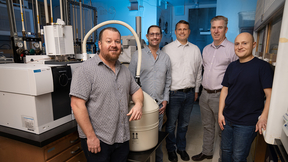Excellence recognized at NNSA Defense Programs Awards for 2022 achievements
 (Download Image)
(Download Image)
Seven teams of LLNL researchers were honored with the Defense Programs Award of Excellence for their outstanding made in calendar year 2022.
In a virtual ceremony held Dec. 14, Lawrence Livermore National Laboratory (LLNL) and the National Nuclear Security Administration (NNSA) recognized six teams of LLNL researchers with the Defense Programs Award of Excellence. One additional award was acknowledged following the ceremony. The awards commend outstanding contributions made in calendar year 2022.
LLNL Deputy Director for Strategic Deterrence Brad Wallin opened the event by thanking staff for their diligent work and by expressing appreciation to NNSA’s Defense Programs for recognizing the Laboratory’s outstanding people and contributions with the awards.
“Today’s ceremony honors teams that span a wide array of the impactful contributions we make to nuclear security from supporting NASA’s DART Mission to achieving ignition at the National Ignition Facility,” Wallin said. “We understand the hard work and dedication that made these achievements possible and we're very pleased to have the chance to highlight them today.”
NNSA Executive Principal Assistant Deputy Administrator for Defense Programs Michael Thompson expressed his admiration for the exceptional teams that were selected for recognition.
“This is an incredible series of accomplishments,” Thompson said. “Recognizing these teams sends the right signal to the entire complex that this is the kind of excellence that, as a nation, we rely on the national laboratories for.”
Established in 1982, the Defense Programs Award of Excellence honors individuals and teams for their significant achievements in quality, productivity, cost savings, safety, or creativity in support of NNSA's Stockpile Stewardship Program.
A recording of the Defense Programs Awards of Excellence ceremony will be available on Strategic Deterrence’s internal website.
The following awards are listed in the order they were presented:
LLNL Weapon-Level Safety Test Series Team
The first award of the day went to the LLNL Weapon-Level Safety Test Series team, recognizing their exemplary support in conducting a series of full system safety tests. This collaborative effort involved Lawrence Livermore National Laboratory, Los Alamos National Laboratory (LANL), Nevada National Security Sites and Sandia National Laboratories.
DART: NNSA Lab Team
The Double Asteroid Redirection Test (DART) NNSA Lab Team received an award in recognition of outstanding support to NASA’s DART Mission. Lawrence Livermore and Los Alamos National Laboratories played a crucial role in providing impact modeling and simulation support over eight years, contributing to the success of the first planetary defense test.
Their work has positioned the NNSA laboratories as interagency leaders on this important national defense topic, which is a growing part of the NNSA labs’ mission to anticipate and mitigate against national and planetary security threats.
LLNL-HPCAT/APS/ANL High Pressure X-Ray Diffraction Equation-of-State Team
The Lawrence Livermore National Laboratory High Pressure Collaborative Access Team was recognized for significant contributions to the delivery of high-fidelity measurements of programmatically relevant materials in a crucial pressure/temperature regime. Their work enhances confidence in NNSA material models.
Complex Hydrodynamics Integrated Experimental Team (IET)
The Complex Hydrodynamics IET received an award for significant capability development and analysis for Advanced Radiographic Capability (ARC) experiments. The team has developed several hydrodynamic platforms that are used to execute a series of high-energy-density experiments designed to investigate relevant phenomena. They played a vital role in investigating and troubleshooting the performance of ARC on the National Ignition Facility.
MJOLNIR Design and Operations Team
The Megajoule Neutron Imaging Radiography (MJOLNIR) Design and Operations Team received recognition for its initiative, dedication, and innovation in redesigning and rebuilding MJOLNIR, leading to record neutron yields. The MJOLNIR Dense Plasma Focus (DPF) team is developing a prototype flash neutron imaging platform, using a DPF as the neutron source. This award recognizes the hard work, dedication, and innovation of the MJOLNIR design and operations teams who have brought this capability one step closer to meeting radiography requirements.
Exceptional Achievement Award: Ignition Team at the National Ignition Facility
The highest honor of the day, the Exceptional Achievement Award, was presented to the Ignition Team at the National Ignition Facility (NIF). Their groundbreaking work culminated in achieving controlled thermonuclear fusion in a laboratory setting, exceeding scientific breakeven.
In December 2022, the team at NIF achieved, for the first time, a chain reaction fusion burn in the laboratory that generated more energy than used to create it. In this milestone experiment, the NIF laser delivered 2.05 MJ of energy to a fusion target that generated 3.15 MJ of fusion output, exceeding scientific breakeven for the first time in history. This accomplishment provides access to crucial regimes of high-energy-density physics, enhancing our understanding of the performance, survivability, and modernization of the nation's nuclear stockpile.
The Exceptional Achievement Award acknowledges extraordinary usage of stockpile stewardship capabilities to promote and further important national security objectives. It recognizes only those efforts and accomplishments that result in an extensive, unique, unusual, remarkable, exceptional or unexpected contribution to the defense program mission.
Special Materials Technology Realization Team
The Special Materials Technology Readiness Team was honored for their outstanding achievement of technology readiness level (TRL) 6 for special materials. The multidisciplinary team of independent subject matter experts, decision-makers, and developers — spanning LLNL, the Y-12 National Security Complex, LANL, Kansas City National Security Complex and Pacific Northwest National Laboratory — advanced the maturity of technology and manufacturing needed to support the production and deployment of special material components within the Nuclear Security Enterprise.
Contact
 Paul Rhien
Paul Rhien
[email protected]
(925) 422-4206
Tags
Nuclear deterrenceStrategic Deterrence
Featured Articles







